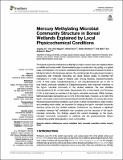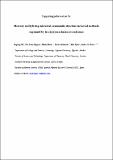Por favor, use este identificador para citar o enlazar a este item:
http://hdl.handle.net/10261/239761COMPARTIR / EXPORTAR:
 SHARE SHARE
 CORE
BASE CORE
BASE
|
|
| Visualizar otros formatos: MARC | Dublin Core | RDF | ORE | MODS | METS | DIDL | DATACITE | |

| Título: | Mercury Methylating Microbial Community Structure in Boreal Wetlands Explained by Local Physicochemical Conditions |
Autor: | Xu, Jingying; Liem-Nguyen, Van; Buck, Moritz; Bertilsson, Stefan; Björn, Erik; Bravo, Andrea G. CSIC ORCID | Palabras clave: | Wetlands Methylmercury Mercury methylation hgcA Community composition Bacteria Mercury Drivers |
Fecha de publicación: | feb-2021 | Editor: | Frontiers Media | Citación: | Frontiers in Environmental Science 8: 518662 (2021) | Resumen: | The potent neurotoxin methylmercury (MeHg) is a major concern due to its negative effects on wildlife and human health. Boreal wetlands play a crucial role in Hg cycling on a global scale, and therefore, it is crucial to understand the biogeochemical processes involved in MeHg formation in this landscape element. By combining high-throughput hgcA amplicon sequencing with molecular barcoding, we reveal diverse clades of potential HgII methylators in a wide range of wetland soils. Among Bacteria, Desulfuromonadota (14% of total reads), Desulfurobacterota_A, and Desulfurobacterota (up to 6% of total reads), previously classified as Deltaproteobacteria, were important members of the hgcA+ microbial community in the studied wetlands. We also identified Actinobacteriota (9.4% of total reads), Bacteroidota (2% of total reads), and Firmicutes (1.2% of total reads) as members of the hgcA+ microbial community. Within Archaea, Methanosarcinales represented up to 2.5% of the total reads. However, up to half of the hgcA+ community could not be resolved beyond domain Bacteria. Our survey also shows that local physicochemical conditions, such as pH, nutrient concentrations, water content, and prevailing redox states, are important for shaping the hgcA+ microbial community structure across the four studied wetlands. Furthermore, we observed a significant correlation between HgII methylation rate constants and the structure of the hgcA+ microbial community. Our findings expand the current knowledge on the hgcA+ microbial community composition in wetlands and the physicochemical factors underpinning spatial heterogeneity in such communities | Descripción: | 14 pages, 4 figures, 1 table, supplementary material https://www.frontiersin.org/articles/10.3389/fenvs.2020.518662/full#supplementary-material.-- Data Availability Statement: The datasets generated for this study can be found in the EBI Archive under accession number PRJEB20882 | Versión del editor: | https://doi.org/10.3389/fenvs.2020.518662 | URI: | http://hdl.handle.net/10261/239761 | DOI: | 10.3389/fenvs.2020.518662 | E-ISSN: | 2296-665X |
| Aparece en las colecciones: | (ICM) Artículos |
Ficheros en este ítem:
| Fichero | Descripción | Tamaño | Formato | |
|---|---|---|---|---|
| Xu et al_2021.pdf | 1,41 MB | Adobe PDF |  Visualizar/Abrir | |
| Xu et al_2021_suppl.pdf | 2,5 MB | Adobe PDF |  Visualizar/Abrir |
CORE Recommender
SCOPUSTM
Citations
11
checked on 01-may-2024
WEB OF SCIENCETM
Citations
10
checked on 26-feb-2024
Page view(s)
61
checked on 07-may-2024
Download(s)
131
checked on 07-may-2024
Google ScholarTM
Check
Altmetric
Altmetric
Este item está licenciado bajo una Licencia Creative Commons

